Companies can maximize the user experience (UX) by fortifying their digital immune system (DIS) using a combination of software engineering, development, automation, operations, analytics and other technical processes. This can bolster business performance, reduce the number of system failures, enable faster and smoother software upgrades, and allow businesses to take advantage of innovative new features for accelerating business speed.
Both digital adoption and digital transformation (DX) are being driven by the need to improve business processes and customer experiences through the use of new and innovative technologies. As such, a resilient digital ecosystem can help businesses accelerate their DX initiatives by allowing them to unlock new capabilities faster than ever.
According to Gartner, by 2025, organizations can increase customer satisfaction by investing in digital immunity and decreasing downtime by 80%. Joachim Herschmann, Senior Director Analyst at Gartner, says, “Enterprises face unprecedented challenges in ensuring resilient operating environments, accelerated digital delivery, and the reliable end-user experience.”
This segment of our ‘Digital Adoption Trend Report ‘outlines how companies can strengthen their digital immune system, using methods such as automated testing and analytics, leveraging artificial intelligence (AI) and deep learning (DL) technologies, and analyzing user behavior to improve the overall user experience (UX).
- What Is The Digital Immune System (DIS)?
- Why Maintaining A Strong Digital Immune System Important
- 6 Requirements Essential For Crafting an Unbreakable Digital Immune System
- How Can Digital Immunity Enhance The Quality of Your Software?
- How To Business and IT Leaders Can Strengthen Their Digital Immune System
- Training For A Digitally Immune Future
What Is The Digital Immune System (DIS)?
A digital immune system can be defined as a set of practices, technologies, and solutions that leverage software design, development, analytics and operations to enhance the user experience (UX) and mitigate business risks. Leveraging data analytics to better inform digital operations and improve the user experience (UX) is one indicator of an effective DIS in action. Another is the deployment of AI-augmented systems that detect suspicious or unusual activity. As such, the parameters of an effective DIS should be able to identify malicious threats in real-time, allowing organizations to respond quickly and effectively.
Ultimately, a digital immune system strategy should integrate software design, complex digital systems, development, operations, and analytics to provide businesses with the necessary protection.
By strengthening security and usability within digital environments, businesses can minimize continuity risks associated with serious application malfunctions or unresponsiveness. For example, a robust DIS will actively safeguard applications and services from anomalies such as security flaws or software bugs and make these platforms resilient and adept at bouncing back swiftly in the event of failure.
Complex digital systems running within a healthy DIS are monitored continuously. Whenever anomalies are detected, the system immediately takes preventive measures to safeguard the platform from potential threats.
Why Maintaining A Strong Digital Immune System Important
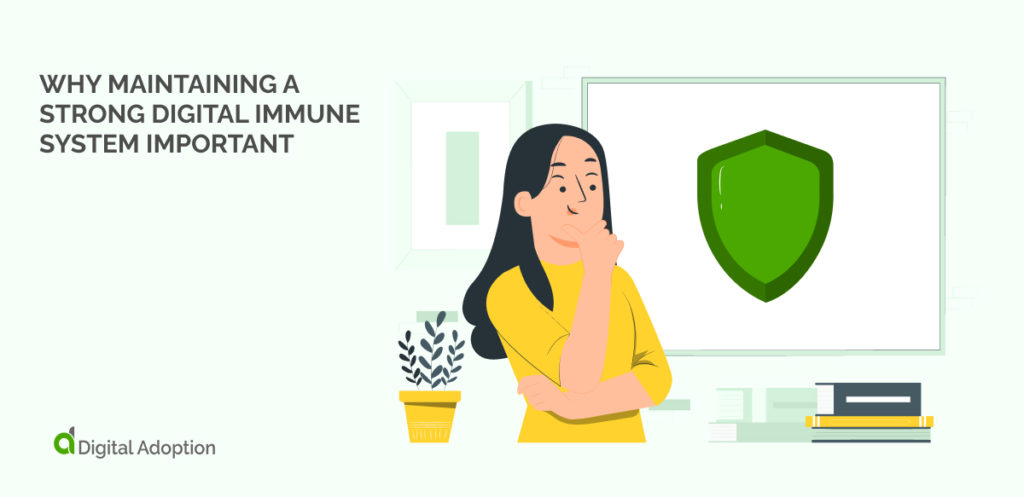
The digital immune system approach optimizes the user experience (UX) and bolsters business performance by combining software development, automation, operations, and analytical technologies. An agile DIS shields applications and services from harm while providing rapid recovery capabilities in case of a system failure.
With a fortified digital immune system, businesses can increase user satisfaction with the provision of enhanced and personalized services, protect customers from malicious activities like data breaches and ransomware attacks and minimize system failures that work to negatively impact digital business operations.
According to a 2021 Gartner survey, organizations that conflate customer satisfaction with “growth, margin, and profitability” are more likely to report customer experience (CX) success, and 29% are more likely to acquire increased customer experience (CX) budgets.
6 Requirements Essential For Crafting an Unbreakable Digital Immune System
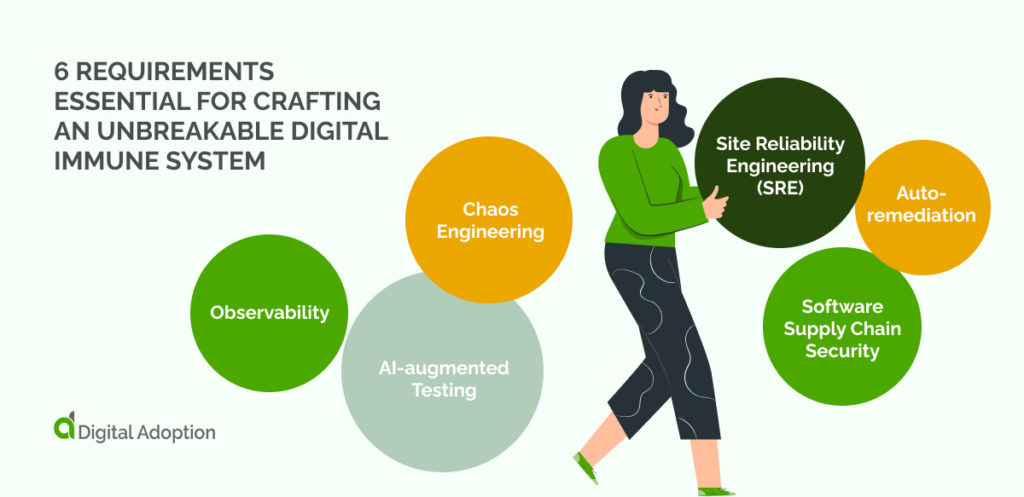
Launching a roadmap that envisions a step-by-step process for building digital immunity within the organization will be required on behalf of IT leaders. This is the first of several phases when accelerating plans for improved digital preparedness.
Others include six primary areas, such as:
- Observability grants software and systems the ability to be tracked, monitored, and assessed precisely. This amplifies accuracy and resilience for different levels of sensitivity but also enhances user experience by analyzing user behavior.
- AI-augmented Testing is transforming how organizations test their software, making it less dependent on manual intervention. It provides comprehensive testing automation for every aspect: from planning to creation, maintenance, and analysis. Automation Testing supports traditional automated testing and extends conventional test automation further by significantly reducing the effort and time spent in each stage.
- Chaos Engineering is a discipline that enables teams to proactively identify and remedy potential issues and vulnerabilities in a sophisticated system. This non-intrusive practice builds confidence in a system’s proficiency by evaluating the pre-production environments before deployment. By mastering this process early on, organizations are better equipped for production hardening with the knowledge of what works or does not work based on their test results.
- Auto-remediation enables your application to self-monitor activity while simultaneously preventing problems from arising in the first place. As a result, you can rest assured that operations personnel will no longer need to be involved when resolving unwanted experiences as they arise, allowing users to enjoy uninterrupted service. Additionally, auto-remediation can repair inadequate UX using chaos engineering combined with observability to mitigate failures.
- Site Reliability Engineering (SRE) revolutionizes customer experience and retention by utilizing service-level objectives to improve service management. This technique helps businesses achieve an optimal balance of speed, stability, risk, and technical debt reduction for development teams so they can dedicate more time to providing users with engaging user experiences.
- Software Supply Chain Security actively combats the danger of software supply chain attacks. Utilizing a Software Bill of Materials (BOM), we create visibility, transparency, security, and integrity for open-source and proprietary code in software supply chains. Adopting strong version control policies with an artifact store provides trusted content management while assessing vendor risk throughout each stage to protect internal and external code from harm or manipulation. To bolster security and mitigate vendor risk, organizations must implement robust version-control policies and use reliable artifact repositories for trustworthy content.
How Can Digital Immunity Enhance The Quality of Your Software?
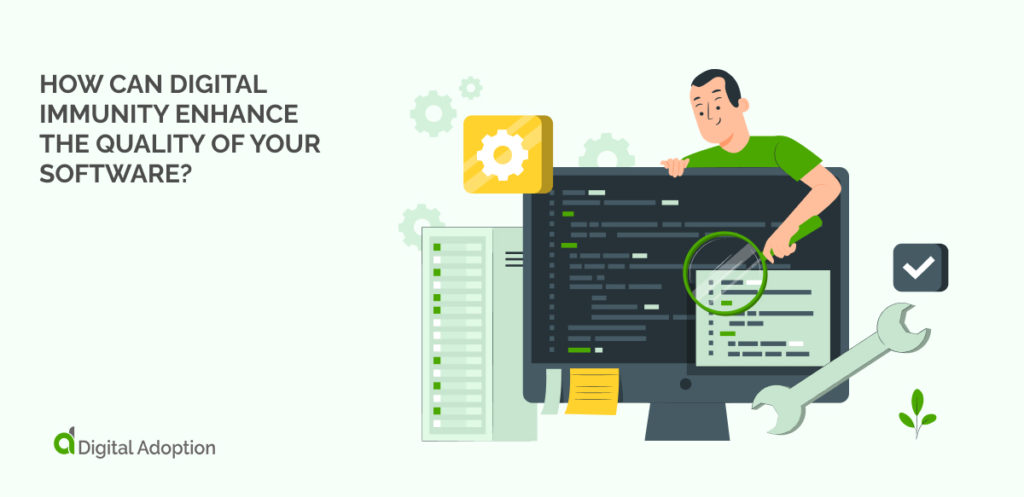
By constructing a strong digital immune system with the six aforementioned practices, software and application engineering leaders can guarantee increased user satisfaction with their applications. Users will also reap the benefits of greater uptime and an enhanced overall experience.
Digital immunity enables the following significant changes in the software and application engineering approach:
- This new perspective promotes a systemic and comprehensive view of quality by reshaping the usual quality-centered approach to applications or projects. This helps to expedite the process of becoming a digitally mature enterprise.
- A dedication to quality is woven into every application development stage, ensuring our solutions satisfy the end user’s needs above all else.
- Identifies the essential responsibilities, tools, and procedures needed to construct reliable applications and appoints personnel with the relevant skills.
- Context-sensitive monitoring capabilities are an essential part of any digital immune system. By combining machine learning algorithms with data from multiple sources, context-sensitive monitoring capabilities provide accurate real-time results.
How To Business and IT Leaders Can Strengthen Their Digital Immune System
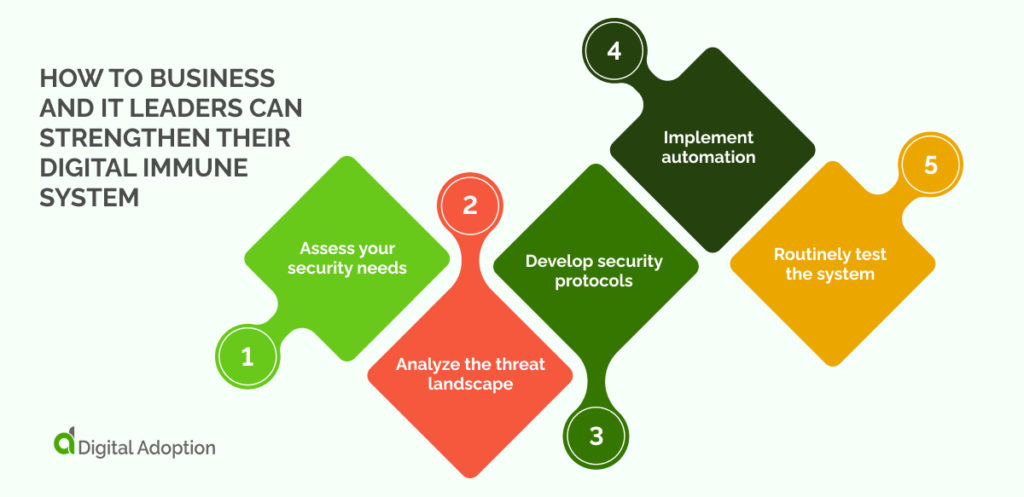
Developing a robust digital immune system requires a multi-faceted approach to engineering. Software and application engineers must be equipped with the right tools and techniques and an advanced understanding of AI methods and principles to create a digital immunity framework that can protect businesses from harm.
The measures taken in constructing an effective DIS vary depending on the project’s requirements; however, there are certain steps we recommend taking to safeguard your software from potential threats:
- Assess your security needs – Begin by identifying any current issues or vulnerabilities so you can focus on the areas where a digital immunity system is most needed.
- Analyze the threat landscape – Monitor your environment for any emerging security trends or threats.
- Develop security protocols – Create protocols tailored to your business’s specific needs.
- Implement automation – Deploy automated tools, such as machine learning or AI-based security solutions, to detect and remediate malicious activities.
- Routinely test the system – Test and validate your DIS regularly to ensure its efficacy.
By following these steps, software and application engineers can create a powerful Digital Immune System that helps ensure their applications’ quality while protecting them from potential threats. With this system in place, businesses can know their data and infrastructure are safe from malicious actors.
Training For A Digitally Immune Future
As businesses become increasingly reliant on digital technologies, investing in digital immunity training is another way to ensure your engineering teams are prepared for the future. Digital immunity training equips software engineers with the skills to develop secure and reliable applications, from designing robust security protocols to utilizing advanced AI-based solutions.
By investing in digital immunity training, software, and application, engineers can gain the confidence to tackle emerging threats, protect their applications from malicious actors, guarantee a better user experience, and bolster digital readiness. Doing so will ensure that businesses continue to innovate with an application development process that prioritizes security and quality.
Organizations are better positioned to increase business speed, agility, and digital delivery of their applications and services by aligning with principles and enacting safeguards that maintain a proficient digital immune system. Hirschmann doubles down on the pertinence of maintaining digital immunity in a workforce that increasingly demands solutions in real-time, sharing: “The business expects to have the ability to react to market changes quickly and innovate at a fast rate. End users expect more than sound functionality — they want high performance and their transactions and data to be secure and satisfactory interactions.”

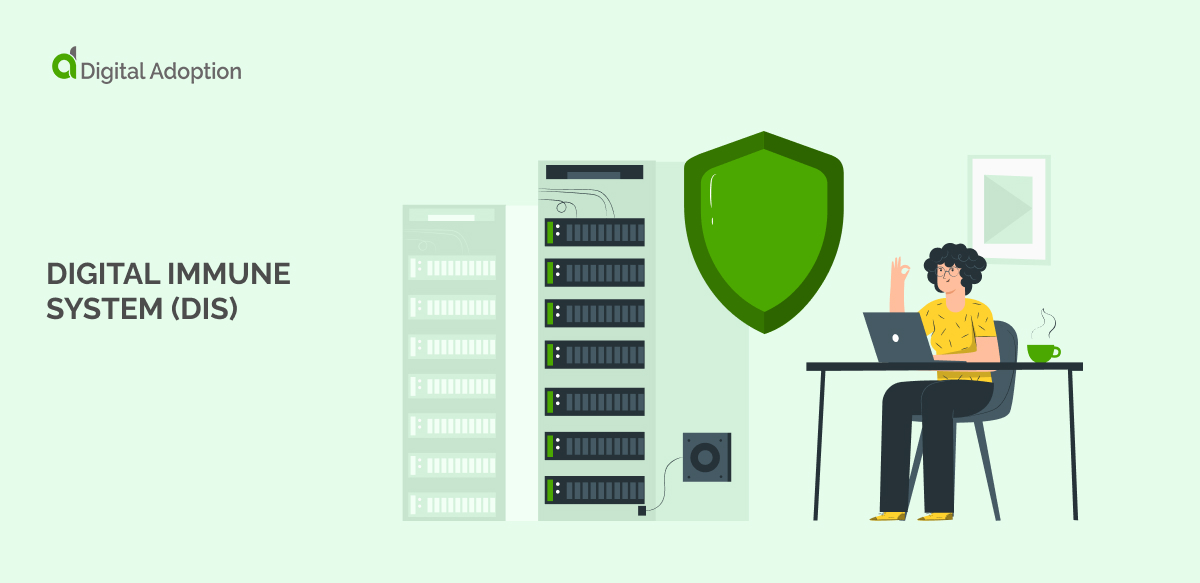


![4 Best AI Chatbots for eCommerce [2025]](https://www.digital-adoption.com/wp-content/uploads/2025/03/4-Best-AI-Chatbots-for-eCommerce-2025-img-300x146.jpg)


![13 Digital Transformation Enablers [2025]](https://www.digital-adoption.com/wp-content/uploads/2025/02/13-Digital-Transformation-Enablers-2025-img-300x146.jpg)



![4 Best AI Chatbots for eCommerce [2025]](https://www.digital-adoption.com/wp-content/uploads/2025/03/4-Best-AI-Chatbots-for-eCommerce-2025-img.jpg)

